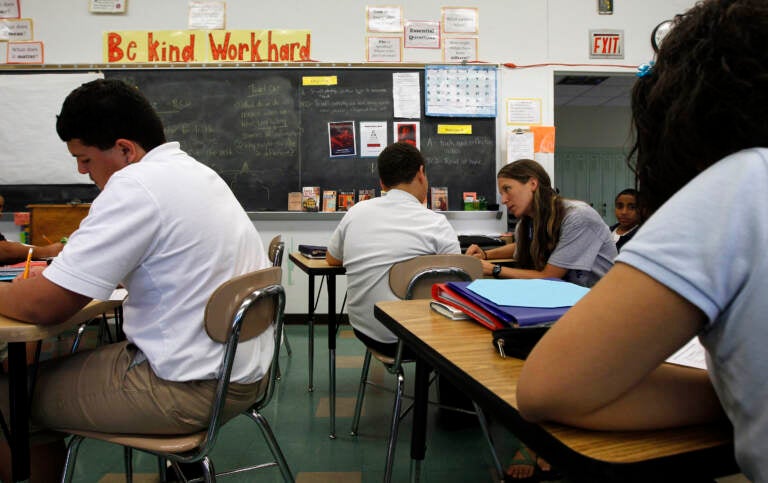From pupil counting to plagiarism, Pa.’s school funding trial takes twists during defense phase
From money matters to plagiarism accusations, the defense portion of Pa.’s historic school funding trial took several twists over the last few weeks.

Teacher Laura Kangay, (center) helps a student with his reading at Lincoln Middle School Friday, Sept. 30, 2011 in Lancaster, Pa. (AP Photo/Alex Brandon)
Republican legislative leaders have wrapped up their defense in a landmark trial over how Pennsylvania funds public education.
They challenged the notion that Pennsylvania schools are desperately and illegally underfunded, with data that suggests the state spends more than average on education.
But their argument — at times — was sidetracked by concerns about the witnesses themselves. One likened teachers unions to cartels on Twitter. Another witness had to be withdrawn after accusations of plagiarism.
It was, in short, an eventful defense.
Here’s a blow by blow of the defense’s case — and how petitioners tried to puncture it.
An ‘irrational and inequitable’ funding system?
At the heart of the lawsuit, filed in 2014, is a basic question: Does Pennsylvania so severely underfund public education that it violates the state constitution?
The plaintiffs, which include six school districts, several parents, and two statewide organizations, contend that the current funding system is both inadequate and inequitable.
Defense attorneys attempted to chip away at that argument by calling Jason Willis to stand.
Willis is a director at the California-based education research group WestEd.
He said Pennsylvania “compares favorably to many other states” in both its funding level and effort — that is, the amount of money it puts into K-12 public education as a percentage of the state’s economic capacity. WIllis argued Pennsylvania’s overall level of funding “is typically one of the highest in the country.”
The commonwealth also compares favorably to other states when it comes to how equitably it distributes resources, Willis said, while adding that there is room to grow.
Willis testified that the state has taken steps to address “issues of inequitable distribution of school funding,” including a fair funding formula that gives extra weight and funds to lower-wealth, higher-need districts.
(Plaintiffs have pointed out that the formula, which went into effect in 2016, only applies to a fraction of the state’s education budget, and argued that it hasn’t done enough to close wide spending gaps between districts.)
As part of his analysis, Willis drew on reports from Education Week and the Education Law Center in New Jersey that grade states on their school funding systems.
On cross-examination, Petitioner attorney Dan Urevick-Ackelsberg pointed out that while the Education Law Center gave Pennsylvania an “A” for funding level and effort, the state received an “F” for equity.
Urevick-Ackelsberg also challenged Willis on some of his methodology, questioning how he calculated districts’ per-pupil spending.
Willis’ report said the Chester Upland School District spends $36,000 per student, while the Pennsylvania Department of Education reported the district spending around $17,000 — or less than half that amount — during the same period.
Willis said his numbers were adjusted for regional cost, but Urevick-Ackelsberg suggested he may have failed to include charter school students in his calculations.
In Pennsylvania, charter school funding passes through school districts. Urevick-Ackelsberg asked whether “even though charter school expenses are in the numerator, you left the charter school students out of the denominator.”
That would effectively inflate per-pupil spending figures in districts with a large number of charter school students, which “tend to be poorer on average,” Urevick-Ackelsberg asserted, adding the calculations “flipped the inequity of Pennsylvania’s school funding on its head.”
Willis said he didn’t know whether he included charter school students in his calculations.
Urevick-Ackelsberg also took issue with Willis’ claims that some school districts are spending money more efficiently than the petitioner districts — that is, spending less per pupil but performing better.
To make this point, Willis produced charts that compared each petitioner district with a set of 20 other districts he identified as peers.
Urevick-Ackelsberg noted that Willis compared the Lancaster School District — where more than 90% of the district’s 11,000 students are economically disadvantaged — to Radnor and Jenkintown, two affluent, suburban districts.
“You found it fair to compare one of the biggest, poorest districts in the commonwealth with one of the smallest, wealthiest districts?” Urevick-Ackelsberg said.
Jenkintown School District serves about 730 students; fifteen percent are economically disadvantaged, and 1.2% are English language learners.
“By what world is one of the poorest biggest districts with the most English language students in the entire commonwealth a fair match with the school district of Jenkintown?” Urevick-Ackelsberg asked.
Willis maintained that when the petitioner districts are compared to their 20-district peer groups — rather than one or two other districts — it is a “reasonable and fair comparison.”
Does school spending correlate to student achievement?
Witness Abel Koury also looked at the connection between funding and student achievement, and whether there is a meaningful relationship between school district spending and academic growth.
Throughout their case, petitioners called up expert witnesses to testify that increased funding can improve student achievement, if properly targeted.
Koury works as a senior research scientist at Far Harbor LLC, a statistical consulting firm in Texas, and has a Ph.D. in developmental psychology.
He analyzed the correlation between how much school districts spend and how they score on the Average Growth Index (AGI), a statewide measure used to gauge students’ progress in a given year.
“Achievement is a singular point in time,” Koury said. “Growth doesn’t just take into account where students score on a particular day, it takes into account where they started.”
Koury analyzed district spending and AGI scores for English language arts, math, science, and writing exams for several grades between the 2013-14 and 2017-18 school years.
He found that there was no meaningful relationship between school spending and student growth, even when controlling for cost of living and demographics.
AGI scores are translated on a scale that ranges from red (the lowest growth scores, including negative growth) to dark blue (the highest growth scores). Green means students made the expected one year of academic growth.
“Essentially, when looking at how funding differed, districts that were in the red level of growth versus the dark blue level of growth, generally speaking, were not different in terms of funding,” Koury said.
During cross-examination, petitioner attorney Dan Cantor challenged the use of AGI to compare school districts and draw conclusions about school funding.
Koury conceded that research is “mixed” on whether value-added growth measures are reliable and valid. There can be wild swings in a district’s AGI classifications from year to year.
As an example, Cantor pointed to the William Penn School District. Its AGI growth scores for English Language Arts switched from blue to red then back to blue in the course of the three years.
Cantor also noted that the model is meant to account for “out of classroom” factors that aren’t under a school or teacher’s control, and said one of those factors is whether a school district is chronically underfunded.
“If [the model]has already controlled for all of the out of classroom factors, including chronic underfunding in the district … then you’re never going to find a correlation between AGI and school funding because it’s already been taken out of the equation. Isn’t that right?” Cantor asked.
“I have to think about that,” Koury said, acknowledging he hadn’t previously considered the question.
Ultimately, he claimed the critique didn’t necessarily discredit his analysis, but agreed that with the statewide student-growth model, “minimally they’re trying to control for different experiences that students are having before entering the classroom” — and “in theory,” that includes attending school in an underfunded district.
Witness withdrawn after accusations of plagiarism
Partway through their case, the defense withdrew one witness after allegations that some sections of his expert report were plagiarized.
Mark Ornstein, former CEO of a Michigan charter school network who also held administrative positions in the Delaware County Intermediate Unit and School District of Philadelphia, was expected to testify about the use of standardized test scores and impact of class sizes on student learning.
After Ornstein was called to the stand, petitioner attorney Dan Cantor objected to his qualification as an expert.
Cantor pulled up multiple portions of his expert report that appeared identical or extremely close to passages by education professors and a Penn State University undergrad.
“I can’t answer exactly what I pulled from what,” Ornstein said, when presented with one example of the alleged plagiarism.
How ‘progressive’ is Pa.’s funding system?
Petitioners also questioned the qualifications of another defense witness, Max Eden, a research fellow at the American Enterprise Institute (AEI), a conservative think tank.
Cantor argued that Eden was appearing on the stand not as an expert who had conducted formal, peer reviewed research on the relationship between education spending and student achievement, but as an advocate.
He asked Eden about several recent tweets, including one that said teachers unions should instead be called “K12 cartels that hold children hostage for ransom,” and another that suggested educators who teach about gender identity may be doing so because they’re trying to “groom” children for molestation.
Eden said he “very much regretted” the post.
Eden was permitted to testify, and argued that Pennsylvania’s education funding has substantially increased over the past few decades.
He asserted that, if Pennsylvania “were to secede and declare itself to be its own republic … it would rank among the highest countries in the world in terms of school finance,” though acknowledged on cross-examination that he did not take health care and pension costs into account, which schools in many other countries are not responsible for paying.
Eden’s expert report included a chart from a study by the Urban Institute showing that Pennsylvania is “slightly progressive” in education spending — that is, it directs more funding to poor students than non-poor students.
“The idea of progressivity is that students in the K-12 setting from poorer backgrounds should get more from the state,” Eden said.
According to the chart, Pennsylvania ranked 24th out of the 49 states rated on progressivity in the 2013-14 school year.
But under cross-examination, Cantor pointed out that in the same report, when progressivity was based on per-pupil spending rather than revenue, Pennsylvania was the most regressive state in the country.
“When you use a spending-based measure of progressivity rather than a revenue-based measure of progressivity, Pennsylvania finishes dead last, does it not?” he asked.
Cantor suggested the discrepancy might be due to the same issue raised during Willis’ testimony, where charter school students are not included in calculations and per-pupil funding figures are inflated.
Alternatives for students
Earlier in the trial, when superintendents and teachers from petitioner districts took the stand, defense attorneys pushed back on the dire pictures they painted of struggling, under-funded schools. They pointed to everything from high-level course offerings to successful athletic programs as evidence that districts were meeting students’ needs.
They also argued that the state provides a variety of quality options for students, in addition to district schools.
Their first witness founded a “Christ-centered” private school in Central Pennsylvania, which students can attend through state tax credit programs. Defense attorneys also called two cyber charter school leaders to the stand.
“It helps to illustrate that, essentially, there is another path or another avenue that has been set up by the General Assembly to provide alternatives for students,” said Anthony Holtzman, an attorney representing GOP Senate President Pro Tempore Jake Corman, in reference to one of the cyber charters.
Margie Wakelin, an attorney for the petitioners, challenged the relevance of testimony from one of the school’s leaders, arguing that cyber charters are a “very limited, small component” of the state’s education system, with just 14 schools serving a “small percentage” of Pennsylvania students.
Holtzman argued that cyber charters are a “piece of the public education system” that Judge Renée Cohn Jubelirer “should be considering and taking account of when assessing whether the system is unconstitutional.”It would be “myopic” to only look at school districts without considering the other options available to students, Holtzman claimed
On the stand, the witnesses representing cyber charters touted their programs.
Maurice Flurie, the former CEO of Commonwealth Charter Academy (CCA) — the state’s largest cyber charter — said the school serves students who “felt like that square peg going into a round hole in a traditional public school classroom environment” and needed “something different” in order to flourish.
At CCA, students have more flexibility to learn at their own pace, Flurie said. On the stand, he walked through a variety of offerings, including a career readiness course and an aquaponics elective.
He also testified that standardized test scores are not the best measure of a student’s educational experience, a point the defense attorneys have hammered throughout the trial.
Flurie said many CCA students enter the school far behind grade level, and noted that cyber charter school students take standardized tests in unfamiliar settings — like hotel ballrooms or banquet halls — with unfamiliar proctors, something that can produce anxiety.
“Standardized tests have a place,” he said, “but as a sole measure, I just think that’s terribly deficient.”
Still, on cross-examination, petitioner attorney Katrina Robson grilled Flurie on students’ performance scores, along with other metrics of student success. She and other petitioner attorneys questioned both the outcomes at cyber charters, and whether they are truly an option for any student who is dissatisfied with district schools.
Robson pointed out that, on a two-year, combined basis, only about 30% of CCA students achieved proficiency on statewide English language arts and math exams, and that the school’s growth score was negative — that is, students regressed academically.
She also noted that the school’s four-year graduation rate is 53%, well below the state’s average. The school’s 10% dropout rate for the 2018-19 school year was about twice the average rate for charter schools and seven times the average rate for school districts.
Brian Cote, the director of curriculum, instruction, and assessment at 21st Century Cyber Charter, touted his school’s flexible schedule for students, course offerings, and academic advisor program.
On cross-examination, Cote acknowledged that cyber education may not be the “best option” for all students, and that the school has a higher-than-average dropout rate for special education students (34%, compared to the statewide average of 13%). Wakelin also presented Cote with data showing that only 0.3% of the student body is English learners.
Private school founder Aaron Anderson represented the kind of brick-and-mortar choice available to commonwealth students. He heads Logos Academy, a private Christian school with 225 students.
About half the school’s budget comes from two-state tax-break programs that fund scholarships for private school students; These programs enable the school to provide an “elite education” to students who live in poverty, Anderson said.
The tax-break programs have come under scrutiny, however — including in a recent report by the state’s Independent Fiscal Office, which found they lack basic accountability measures.
Can you measure the cost of education?
The defense’s final witness, Eric Hanushek, took issue with a study that informed one of the petitioners’ key claims: that Pennsylvania schools are underfunded by $4.6 billion.
That figure was part of an analysis from Pennsylvania State University professor Matthew Kelly, who prepared an expert report for the petitioners and testified that the state’s poorest districts are the most shortchanged. He based his figure on a 2007 “costing out” study, commissioned by the Pennsylvania legislature, to determine how much it would cost to provide students with what they need to meet state standards.
Hanushek, a fellow at the Hoover Institution at Stanford University, argued the 2007 study “is not a reliable or trustworthy guide of what the state should do.”
He took issue with what he called the fundamental assumption of costing out studies — “that there’s some systematic and consistent relationship between resources provided to schools and the outcomes of students” — and argued that the relationship between spending and student achievement is “unknown.”
“We have no empirical basis that allows us to take a given goal for achievement and translate that into some required dollar amount,” Hanushek said.
He also said the goal of the study — figuring out what it would cost for Pennsylvania students to reach 100% on reading and math — is unrealistic.
“I know of no school, state, country that has ever achieved 100% proficient,” Hanushek said.
The 100% target was set by the federal No Child Left Behind law, which is no longer in place.
On cross-examination, petitioner attorney Maura McInerney noted that bipartisan legislatures have commissioned costing-out studies to calculate how much it costs to educate their students, and that courts have cited those studies during school funding lawsuits. But Hanushek insisted that the studies provide “bad information.”
Hanushek did concede that some studies have found a connection between increased school spending and a rise in student achievement.
“I believe that money can matter,” he said. “It probably, at times, matters. The problem is that we don’t know when it’s going to matter.”
He also agreed that schools can successfully educate children from disadvantaged backgrounds “if we use our resources well,” and that he supports targeted funding for disadvantaged students — something he said “every state in the nation” already does.
“You have stated and acknowledged that if a school district efficiently spends additional funding that it would lead to higher achievement,” McInerney said.
“Of course I believe that if you do it good, you do it good,” Hanushek said.
What’s next?
The petitioners will call a rebuttal witness, or witnesses, next week.
Judge Cohn Jubelirer will decide whether the sides should make closing arguments. The petitioners would like to, but the legislative respondents say they’re not necessary.
Regardless, it could take months before the judge issues a final ruling on the case.
Whatever the outcome, the losing side is expected to appeal, potentially kicking the case up to the Pennsylvania Supreme Court.

Saturdays just got more interesting.
WHYY is your source for fact-based, in-depth journalism and information. As a nonprofit organization, we rely on financial support from readers like you. Please give today.








